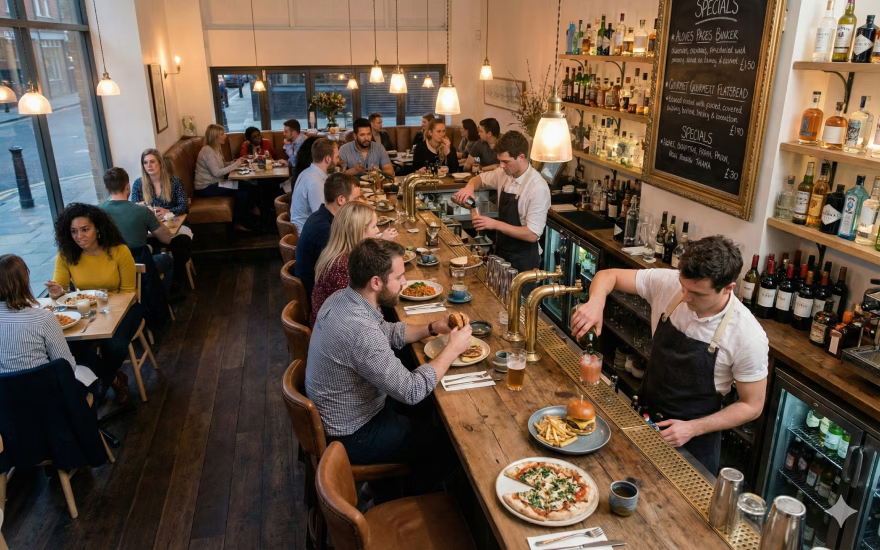Going Viral: How to Elevate Your Restaurant’s Social Media Strategy

In today's digital era, restaurants cannot afford to disregard the importance of social media if they want to stay relevant and stand out. Given that 90% of diners conduct online research to check out restaurants before dining, social media for restaurants can’t be overstated.
Restaurants with a social media presence can effectively reach out to a larger audience and engage with them in real time. Social media lets restaurants show off their menu, run ad campaigns, tell customers about special deals, and connect with them, all of which help build brand loyalty.
Restaurant social media marketing likewise provides an opportunity for those in the industry to gain valuable insights into consumer preferences and behaviors. Restaurants can track engagement metrics such as likes, shares, and comments to gain insights into which menu items are popular, what promotions drive traffic, and what customers say about their experience.
The good news is that you have a variety of platforms to choose from when it comes to social media marketing. Facebook, Instagram, Twitter, and TikTok are the most popular social media platforms for restaurants. If you are new to social media, check out this introduction to social media marketing for restaurants, which covers the basics of each platform.
Social Media for Restaurants: Maximizing Your Restaurant's Online Presence
People spent an average of 147 minutes daily on social media in 2022. Restaurants that want to grab a chunk of their customers' online time must implement an effective social media marketing strategy.
Here are some key benefits of utilizing social media as a marketing tool for your restaurant.

Social media increases brand awareness and exposure
90% of marketers have experienced a notable increase in business exposure through social media marketing, while 75% have reported a rise in website traffic. With social media, you can display current menu offerings, launch promotions and events, and engage with both existing and potential customers.
Social media is the most cost-effective marketing channel
Social media advertising is three times more cost-effective than traditional advertising like print and television ads. Compared to other forms of advertising, social media has the lowest cost per thousand impressions (CPM), at only $2.50 per CPM.
Online communities improves customer engagement and loyalty
By being responsive to customer inquiries and feedback, along with sharing engaging content, restaurants can establish a community or a group of loyal fans.
Social media marketing provides valuable insights and data
Restaurant social media marketing provides crucial insights and data. You can gain useful information about your customers, like their preferences and demographic information. You can also receive direct feedback on why they like your restaurant, what dishes are most popular among different demographics, and the types of content that are most effective. By communicating directly with your customers in a casual, no pressure setting, you can gain invaluable insights to improve your restaurant.
Social Media for Restaurants: 5 Social Media Strategies to Employ
Social media has evolved into an indispensable element for restaurants to connect with their customers in new and unique ways. Since there are so many restaurants online competing for attention, it's important to come up with a social media marketing strategy that will help your restaurant stand out and go viral.
1. Share Visual Content of Your Restaurant and Dishes
Restaurants can use social media platforms to post high-quality photos and videos of their menu items and ambiance. To make posting easier, you can use free Instagram post templates to help you create designs. Customers often make dining decisions based on how appetizing the food looks, and social media provides an excellent opportunity to showcase the restaurant's best dishes.
Create visual storytelling. Use visually striking content, like mouth-watering food photography, a cozy nook in your restaurant, or behind-the-scenes glimpses of your restaurant's unique personality. When sharing videos, using transcription software to add captions can further improve accessibility and help reach a wider audience. To stay consistent with your content and post at optimal times, consider using an Instagram scheduler. This tool allows you to plan, schedule, and automatically publish your posts, saving time and maintaining a steady online presence. When publishing, use relevant hashtags to make it easier for potential customers to find your establishment.
For example, Starbucks frequently posts mouth-watering images of their seasonal drinks and desserts, which attracts attention and increases engagement.

2. Leverage User-Generated Content (UGC)
User-generated content (UGC) is an effective social media strategy for restaurants, as it encourages customers to share their dining experiences online. It provides authentic, peer-to-peer recommendations that potential customers trust and relate to. By sharing images and positive reviews, customers become ambassadors for the restaurant, promoting it to their social media followers. Additionally, you can use user-generated content to showcase your restaurant's dishes, ambiance, and unique features, creating a sense of community and personal connection with your audience.
For instance, Shake Shack regularly features customer-generated content on its Instagram account. The restaurant encourages customers to share their photos and videos of their meals with the hashtag #shakeshack, which the burger company reposts on its page.
Influencer marketing is similar to UGC, except influencers generally have either a large or niche follower base. Collaborating with influencers can be an effective way to reach new audiences, especially when you are targeting a specific demographic. Restaurants can work with influencers that share their values and brand image, offering them payment in exchange for promoting the restaurant on their social media platforms. It's important to note that influencer marketing may be costly, particularly for small to mid-sized establishments.
3. Host Social Media Contests and Giveaways
Running contests and giveaways on social media platforms can help restaurants engage with their followers and attract new customers. This strategy can help build brand awareness and loyalty, increase engagement, and drive traffic to the restaurant.
There are various ways to run a giveaway. You can host them informally, giving your Facebook or Instagram followers a chance to win by commenting on or liking a post. If the prize is large enough, you may opt to run a photo contest where customers post photos of their favorite dishes and tag the restaurant's account. You can also host your contest using a third-party giveaway tool. This opens up the contest to everyone, while allowing you to receive people's email addresses, which can then be used for email marketing.
Prize options are endless, but gift cards and free meals tend to work best – and they get new customers in the door!

4. Engage With Customers on Your Social Media Channels
Social media should be treated like a live conversation. Liking and commenting on your customers’ tagged photos of your restaurant fosters a sense of community. It shows that you see them and value their patronage. Also, social media provides an opportunity for restaurants to respond to customer feedback and complaints in real-time. Responding to customers promptly and professionally can help build a positive reputation and customer loyalty.
For example, Wendy's is known for its witty responses to customer inquiries and complaints on Twitter, which has helped them build a loyal following.
5. Create Viral Videos — The King of Social Media Content
Video content on social media platforms has a higher rate of engagement than other types of content. Millennials and Gen Z enjoy this type of content, particularly if it’s humorous, fun, and creative. Restaurants can leverage this trend by sharing behind-the-scenes videos, cooking tutorials, humorous reenactment videos, and other engaging content.
By creating short, eye-catching videos, you can capture the attention of potential customers and showcase your restaurant’s menu items in action. Using tools like an AI humanizer can make your captions, scripts, or translations feel more natural and engaging, which increases curiosity and drives traffic to your restaurant.
For example, Tasty, a popular food channel, creates short, easy-to-follow recipe videos.
Final Thoughts on Elevating Your Restaurant's Social Media Strategy
Incorporating a social media marketing strategy is crucial for any business, and not having one means potentially losing out on revenue. Social media is a powerful tool for restaurants to increase brand recognition, interact with current customers, and attract new clientele. By implementing effective social media strategies, you can optimize your marketing campaign and increase the chances of your establishment going viral.



